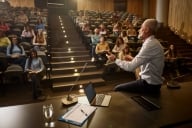You have /5 articles left.
Sign up for a free account or log in.
Computer science might not be the first field that springs to mind when thinking of the liberal arts, but at some colleges, interdisciplinary computing is seen as one way to connect the department to other disciplines on campus.
Bates College, a liberal arts college in Maine, may be the most recent example. The college, which enrolls about 2,000 students, doesn’t offer anything resembling a computer science program -- not even a concentration. Given the chance to create one from scratch, the college will in 2017 introduce digital and computational studies, an interdisciplinary program that fits the label of neither computer science nor digital humanities.
“‘Digital and computational studies’ is a bit more capacious,” Matthew R. Auer, dean of the faculty and vice president of academic affairs, said in an interview. “It’s inclusive of the notion that we’re dealing with the visualization of data, we’re dealing with big data. ‘Computer science’ does have a kind of old-fashioned quality to it.”
The program is one example of how a college whose main focus isn’t technology is adjusting to the times. That type of change is manifesting itself in different ways across the liberal arts sector of higher education. At Barnard College, students entering this fall will experience a new core curriculum with a technology requirement. Also this fall, Mount Holyoke College will introduce a concentration in data science.
But colleges sometimes face an uphill climb to persuade faculty members to support programs that may fall outside the traditional liberal arts. Some, Bates included, have chosen an interdisciplinary approach, framing computer science as an “enabler” for other disciplines -- a way to help faculty members in other departments introduce computing in their own courses.
Clayton Spencer, who became president of Bates in 2012, said the college is responding to feedback from parents and students who say employers are looking for applicants with a liberal arts background yet who also know how to code.
“The worlds of work and social relationships are all being transformed by digital platforms, computational thinking and the reality of digital connectivity,” Spencer said. “It’s incredibly important to embed the learning about these platforms and tools in the context of the liberal arts.”
That liberal arts vision for computer science has so far gained the support of the faculty body at Bates, which endorsed the college's plan without major dissent. (It also helps that program is paid for. Bates College is using a $19 million gift commitment -- the largest in the college’s history -- to hire six new faculty members, three of whom will shape the digital and computational studies program.)
The program, which -- if the college’s timeline holds -- will launch in fall 2017 with a full major the following year, will still look familiar to anyone who has spent any time in a computer science department. But once students finish foundational courses in coding and programming, they face a decision about how to specialize. They could choose a “deep dive” in artificial intelligence or big data, Auer said, or pick a pathway that leads through a different departments or majors, exploring textual analysis in a literature course or data visualization in a chemistry course.
“It was super important to us that we have a really strong grounding in the classical computer sciences as we build this program as well as the ability to swing into interdisciplinarity and not have simply a digital humanities focus,” Spencer said. “I don’t think that would be serving our students well.”
‘Relentless’ Growth
The program also gives Bates access to students it might not have been able to market itself to before. The Computing Research Association, a group of more than 200 computer science departments, has described the growth of undergraduates majoring in computer science as “relentless.” The Association for Computing Machinery, which conducts annual surveys of enrollments in non-doctoral-granting departments such as those at liberal arts colleges, last September found institutions during the 2014-15 academic year expected a 21.7 percent jump in computer science bachelor’s degree production from the year before.
“There’s a huge pressure point for everybody on how to serve these students,” said Jodi L. Tims, a professor of computer science at Baldwin Wallace University, who co-wrote the report.
Tims, chair of the department of mathematics and computer science at Baldwin Wallace, a liberal arts college in Ohio, said she is seeing a growing diversity in the types of programs colleges offer. During her 14 years at Baldwin Wallace, for example, the computer science department has doubled the number of programs it offers from two to four and added an interdisciplinary major, she said.
Program diversity is not an automatic strategy for success, however. Not only do niche programs appeal to a smaller group of prospective students, but they are also expensive to run, Tims said. The main challenge for a computer science department at a liberal arts college, she said, is to use the credit hours it is allotted effectively. While departments at colleges without an expansive core curriculum can design a major using more than half of the typical 120 credit hours needed to graduate, departments at liberal arts colleges often have to do with much less. The major at Baldwin Wallace consists of about 50 credit hours of course work, which Tims said is still considered a large major for a liberal arts college.
“You have to be very savvy in how you create a curriculum so that students get enough of what they need to be able to sell themselves for that first job,” Tims said. “You have to build the idea that students that come from liberal arts institutions are broader thinkers. Tech skills get you in the door. Your ability to communicate, to see the bigger picture and work together with others really help people develop more quickly in the career space.”
Looking Beyond the Department
As Bates over the next few years works to strike that balance between tech and liberal arts skills, it may look to Union College, in New York, which Tims highlighted as an institution that has made a big push for interdisciplinary computing.
Union’s computer science program dates back to the 1970s, but it has over the last several years introduced changes to expand its appeal. The changes include developing introductory courses around themes such as game development, robotics and media computation, which last academic year attracted students from more than 30 different majors.
Valerie Barr, professor of computer science at and chair of the ACM’s Council on Women in Computing, said in an email that a liberal arts background serves as a strength rather than a weakness for students entering the job market with a computer science degree.
“The majority of computing jobs today are not housed solely within the tech industry,” Barr wrote. “More appropriately, every field is now a tech field, and students who can work at the intersection of disciplines will be at an advantage.”
Computer science majors at Union are free to major exclusively in the discipline, double major or add a minor, but they can also pursue an interdepartmental major -- a combination of two disciplines with one capstone project that satisfies both. Students have combined computer science with majors such as art, philosophy and psychology, Barr wrote. The department also helps faculty members in other fields use computing in their own courses.
“This is yet another way by which Union students see the role computing can have in other fields,” Barr wrote.
Bates last September launched a similar project, called the Digital Course Design/Redesign Initiative, for faculty members interested in adding digital and computational tools or methods to existing courses. If it becomes popular among faculty members, the initiative could help realize Bates’s plans of having interdisciplinary pathways for its digital and computational studies majors. Auer, the Bates dean, acknowledged that building those pathways is “going to require deep consultation with the faculty” -- as well as some new faculty members in other departments.
“When we add new hires in economics, in politics, we are looking precisely to bring digital and computational methods,” Auer said. “But if there’s no underlying program in computer science, then it means there’s just so far a person can go.”








